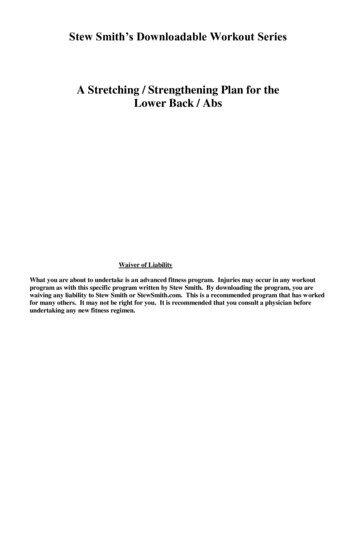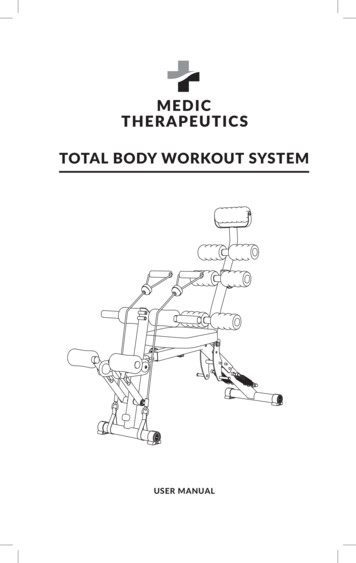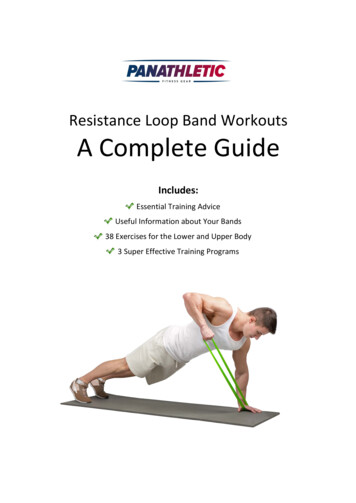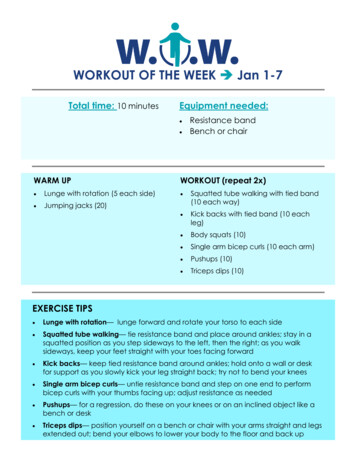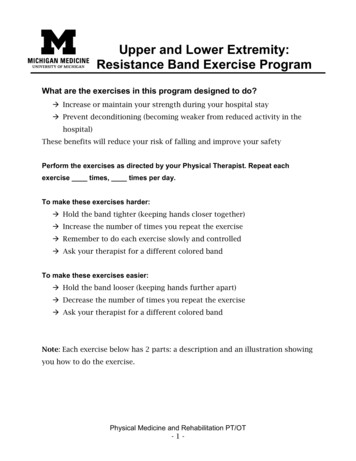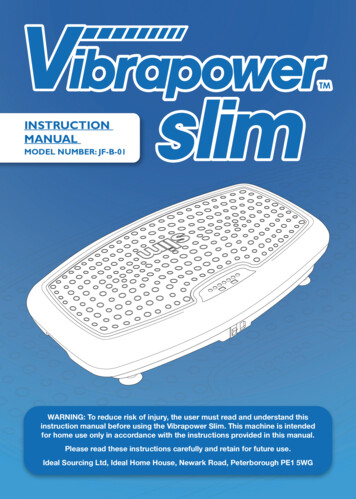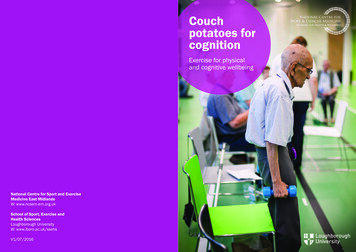
Transcription
Couchpotatoes forcognitionExercise for physicaland cognitive wellbeingNational Centre for Sport and ExerciseMedicine East MidlandsW: www.ncsem-em.org.ukSchool of Sport, Exercise andHealth SciencesLoughborough UniversityW: www.lboro.ac.uk/ssehsV1/07/2016
Seated resistanceband workoutA number of scientific studies have shown that resistance or strengthtraining is beneficial in slowing the cognitive and physical decline ofpeople suffering with dementia.This workout aims to improve your upper and lower body strength, whichprovides benefits for walking, climbing stairs, standing from a chair, holdingitems in your hands and co-ordination of your arms and hands in daily tasks.Things to remember:Top tips:Warm up Try to hold in your stomach musclesbefore moving the particular limb thatthe exercise is aimed at – this willhelp with balance.You should briefly warm up before starting theworkout so that your body is ready. This only needsto raise your body temperature and heart-rateslightly. A brief three to five minute low intensitywalk would be enough.DizzinessWhen standing up from the couch betweenexercises, be careful not to stand too quickly toavoid feeling dizzy. If you do feel any dizziness,immediately stop the exercise and take rest on achair. If you continue to feel dizzy during exercise,you should visit your GP.Muscle sorenessWhat equipment do I need?You will need a resistance band to performthis workout. You can use different grades ofresistance bands depending on your currentstrength and the colour of the band denoteshow much resistance the band has (seeopposite page).How many times should I repeateach exercise?The number of times you repeat each exercise willdepend on your comfort. Repeat the exercise asmany times as you can and aim to increase thisnumber each time.You will also need a couch or chair – make sure itis safe to use by checking whether it is stable andwill not move throughout the exercise.To begin with, complete the exercise once andincrease this gradually, aiming to repeat theexercise 10 to 12 times (if you feel comfortabledoing so).Suitable clothing should be worn. Clothes shouldbe comfortable and reasonably loose, withoutzips, belts or anything else that may cause injury.Remember to breathe throughout, don’t holdyour breath!When should I do the workout?This workout only takes 30 minutes, so youcan do it whenever is convenient for you. It isrecommended that there is someone else with youwhen you are exercising – why not do the workouttogether with your partner or friend?How often should I do the workout?The workout should be completed at least twice aweek to form part of your resistance exercise asrecommended by the Department of Health. Findout more about exercise recommendations activity-guidelinesHow much rest should I take?Rest for 60 to 90 seconds between each exerciseor set of exercises. You can reduce your restperiod to make the workout more difficult asyou progress.Can I make the exerciseseasier or harder?Resistance bands are a great tool to makeexercises easier or more difficult. Simply increasethe length of the band from the resistance pointto make the exercise easier, or reduce the lengthof the band from the resistance point to make theexercise harder. Alternatively, you can choose aband that has increased resistance.You might feel some muscle soreness in the daysafter you exercise. This may happen as early asthe following day and you may feel it for up to oneweek; however this is nothing to worry about. Ifthe pain continues or you have any concerns, youshould visit your GP. When extending either your arms or legs,be sure not to ‘lock out’ your joints, keepa slight bend at the elbow or knee. Make sure you breathe normallythroughout all exercises and try to avoidholding your breath. Make sure you have eaten within thelast two hours, but not directly beforeexercising. Have a glass of water to handin case you get thirsty. Try doing the exercises with a partner tohelp motivate you (and check you aredoing the exercises right!).Resistance band colours:Black – heaviest resistance, hardestband to stretch and pullAdvancedBlue – heavy resistanceGreen – medium to heavy resistanceRed – medium resistanceYellow – light resistance, very stretchyBeginner
How will theexercises help you?Each exercise has a set of icons associated withit showing how it can help a particular daily task.Climbing stairsStandingCo-ordinationGetting dressedPreventing fallsShoppingWashing/taking a showerStanding froma chairGardening
Tummy rotation1. Sit on your chair with your legs comfortablybent and your feet flat on the floor. Wrap yourresistance band underneath your feet and holdthe ends of the band in each hand.2. Pull the band with your right hand and turnyour torso to the right at the same time so thatyou feel your stomach muscles working.Straight arm pull4. Repeat the process on the other side, pullingthe band with your left hand and turning yourtorso to the left5. Slowly return to the middle until the resistanceband is held evenly with each hand and repeaton both sides.1. Sit on your chair with your feet shoulder-width3. Raise your arms until they are at shoulder2. Slowly begin to pull the band outwards on4. Slowly begin to lower your arms.5. Bring your arms back down to your side atapart. Wrap your resistance band underneathyour feet and hold the ends of the band ineach hand.either side of your body, making sure you donot sit forward in your chair.height, ensuring you do not ‘lock out’your elbows.hip height and repeat the exercise.3. Slowly return to the middle until the resistanceband is held evenly with each hand.1245312453
Leg pressCross and pull1. Sit on your chair with your legs shoulder-widthapart. Wrap your resistance band underneathyour feet and hold the ends of the band ineach hand.2. Cross the band over in each hand.3. Pull the band up to shoulder height with your4. As you begin to straighten your arms, try toslow the movement down and avoid ‘lockingout’ your elbows.1. Sit on your chair with your feet shoulder-widthapart and your back straight. Bend one kneetowards you and loop your resistance bandaround the bottom of your foot, holding oneend of the band in each hand.5. Repeat the exercise.2. Push your leg out straight in front of you245movement and ensure you do an evennumber of movements on each leg.Note the images also show a side viewof how to perform the exercise.without ‘locking out’ your knee, squeezeyour leg muscles as hard as you canthroughout the movement.elbows pointing out. You should be able to feelyour back muscles under your armpit tightenas you perform the movement. Try to avoidleaning forward in your chair.13. Bend your knee again to repeat the312453
Find out moreDementia research at LoughboroughSchool of Sport, Exercise and Health SciencesLoughborough UniversityLeicestershireLE11 3TU UKE: dementia@lboro.ac.ukW: www.lboro.ac.uk/research/dementiaUseful linksAlzheimer’s Research UKW: www.alzheimersresearchuk.orgDementia FriendsW: www.dementiafriends.org.ukMind For YouW: www.mindforyou.co.ukReferences1. Ahn N, Kim K, (2015), Effects of an elastic bandresistance exercise program on lower extremitymuscle strength and gait ability in patients withAlzheimer’s disease. J Phys Ther Sci. 27(6):1953-52. Bossers WJ, van der Woude LH, Boersma F,Hortobágyi T, Scherder EJ, van Heuvelen MJ,(2015), A 9-Week Aerobic and Strength TrainingProgram Improves Cognitive and Motor Function inPatients with Dementia: A Randomized, ControlledTrial. Am J Geriatr Psychiatry. 23(11):1106-163. Wittwer J., (2015), Gait improves after 12weeks of intensive resistance and functionaltraining in people with mild to moderate dementia.J Physiother. 61(2):97Please noteLoughborough University strongly recommends that you consult with your physician before commencing any exercise programme.You should be in good physical condition and be able to participate in any exercises.Loughborough University is not a licensed medical care provider and represents that it has no expertise in diagnosing, examining, ortreating medical conditions of any kind, nor in determining the effect of any specific exercise on a medical condition.You should understand that when participating in any exercise or exercise programme there is the possibility of physical injury. If youengage in any of the exercises in this leaflet, you agree to do so at your own risk, are voluntarily participating in these activities, assume allrisk of injury to yourself, or caused to others through your actions and agree to release and discharge Loughborough University from anyand all claims or causes of action, known or unknown, arising out of the content of this leaflet, whether through Loughborough University’snegligence or otherwise.
the length of the band from the resistance point to make the exercise easier, or reduce the length of the band from the resistance point to make the exercise harder. Alternatively, you can choose a band that has increased resistance. Resistance band colours: Black - heaviest resistance, hardest band to stretch and pull Advanced Beginner

